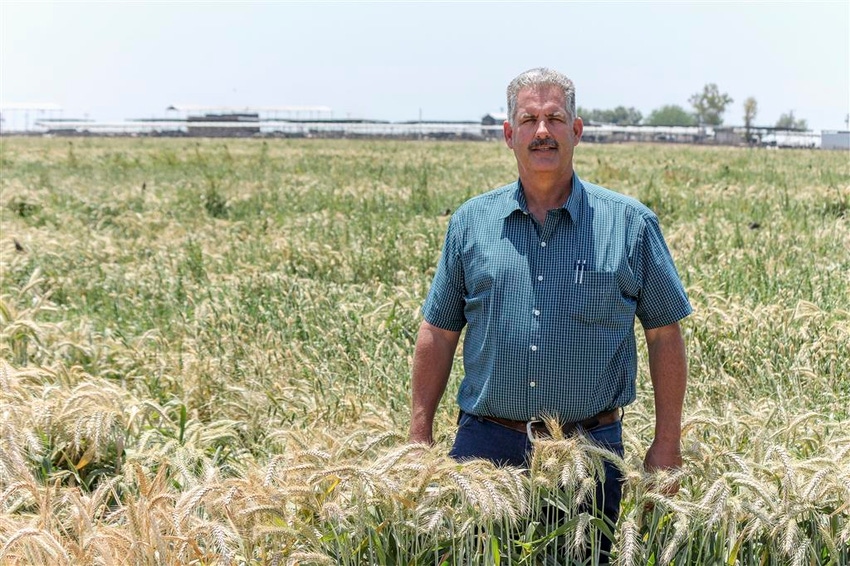
For the most part, finding one or more endangered species on the farm is not a good thing for sustainable farming practices – at least not from a business standpoint.
Tulare County Calif. dairy farmer Frank Mendonsa was faced with that in mid-spring when an estimated 2,500 Tricolored Blackbirds made a temporary home in his triticale, a forage crop grown for dairy cattle feed.
While this is not the only example of Tricolored blackbirds seen in forage crops, this is the largest colony that John Labandeira, Western United Dairymen (WUD) field representative, has witnessed.
Because the crop was nearly ready to chop, Mendonsa, owner of Oak Creek Jerseys in Tipton, Calif., had a decision to make. That’s when he picked up the phone and contacted Labandeira.
“When I first saw the birds I needed to do some research on them,” Mendonsa said. “Through that research I’ve developed an appreciation for the Tricolored Blackbird.”
The Tricolored Blackbird was granted endangered species protection by the California Fish and Game Commission in late 2014 on a temporary, emergency basis because statewide surveys showed the statewide population to be down 64 percent over a six-year time span.
According to Audubon California, the Tricolored Blackbird was among the most numerous California birds during the 19th century. Since then, the population has declined from somewhere in the millions to under 150,000 today. The bird lives almost entirely in California and prefers to nest in wetlands from March through July.
The birds nest in large colonies in Central California, typically making a home in marshes and wetlands.
Fortunately for Mendonsa all was not lost with the appearance of the protected blackbird. Federal Environmental Quality Incentives Program (EQIP) funds through the Farm Bill allowed him to delay harvest of 80 acres of triticale while fledgling blackbirds hatch and learn to fly.
The program pays Mendonsa $600 per acre to delay harvest until the blackbirds migrate elsewhere.
Mendonsa, currently chairs the WUD Board of Directors. He and his trade group partnered with Audubon California, the National Resource Conservation Service, Dairy CARES and others to promote protection of the blackbird and enhance the possibilities of nesting success on farmland.
Challenges
Mendonsa farms 215 acres of triticale near his Tipton dairy. Once the triticale is harvested, he plants corn for silage for dairy cows.
While he was paid to delay harvesting part of his triticale crop, this action reduces its forage quality, according to Mendonsa. For some of it he will lose all of the feed value it could provide his milk herd.
It also delays planting of the corn grown for dairy feed. Mendonsa milks about 1,000 jersey cows from the adjacent Oak Creek Jersey Farm. He has other farming and dairy operations in Tulare County.
“It’s not just the delay in harvesting the triticale,” he says. “It’s the snowball effect of not being able to plant corn silage on time.”
Mendonsa expects to lose yield from his corn crop as well due to delayed planting and harvesting schedules.
“As long as these birds keep on nesting. it pushes the time table back further,” he continued.
The delays could push back corn planting to the second half of July.
The net effect is Mendonsa will have to find forages on the open market for his dairy cows. That may not be possible, according to Labandeira, as the drought and lack of water has restricted planted acres of crops.
Still, Mendonsa believes helping the endangered blackbird “is just the right thing to do.”
Rebuilding populations
According to Alan Forkey, assistant state conservationist with NRCS, his organization partnered with Audubon California to help protect endangered birds with Farm Bill dollars.
Forkey said the Tricolored Blackbird prefers to nest in wetlands, but the opportunity is not there this year as drought has claimed natural wetlands for the blackbird.
The program Mendonsa is a part of is considered a voluntary conservation effort, according to Forkey. Even so, any instance where a farmer might harm or kill an endangered species is considered a “take” under the law and is therefore a prosecutable offense.
Part of Forkey’s efforts includes making farmers aware of the voluntary programs and financial incentives involved.
“There are still some landowners who probably do not know about these efforts,” Forkey said. “We hope to be successful in turning these populations around.”
Jesse Bahm, a biologist with the NRCS, says forage blends such as triticale appear to be a popular choice for the blackbird, which will nest in the San Joaquin Valley before heading north to the Sacramento Valley. Bahm has not witnessed the blackbird in wheat.
Audubon California Conservation Project Manager Samantha Arthur said the drought has caused blackbird populations to move into areas they may not otherwise go – like triticale fields next to dairy farms. Still, the location seems to work for the blackbird as WUD's Labandeira said the birds have easy access to insects, feed and water.
Arthur said a colony of about 20,000 nesting Tricolored Blackbirds was spotted nesting in nearby Alpaugh in southwestern Tulare County. Audubon California is working on wetlands enhancement and restoration in that area, which like the rest of California, is suffering from severe drought.
“These birds are fighters,” she said. “I think they have a chance of survival with partnerships with farmers like Frank.”
While visiting the farming operation it was easy to spot the birds and the beeline they would make from the triticale to the commodity shed while feed was mixed for the dairy cows.
“There they go,” said Mendonsa, pointing to the birds flying from their nesting area in the triticale to piles of feed being moved into the mixing wagon.
“This is a sight you don’t see very often in California,” Labandeira said.
About the Author(s)
You May Also Like






